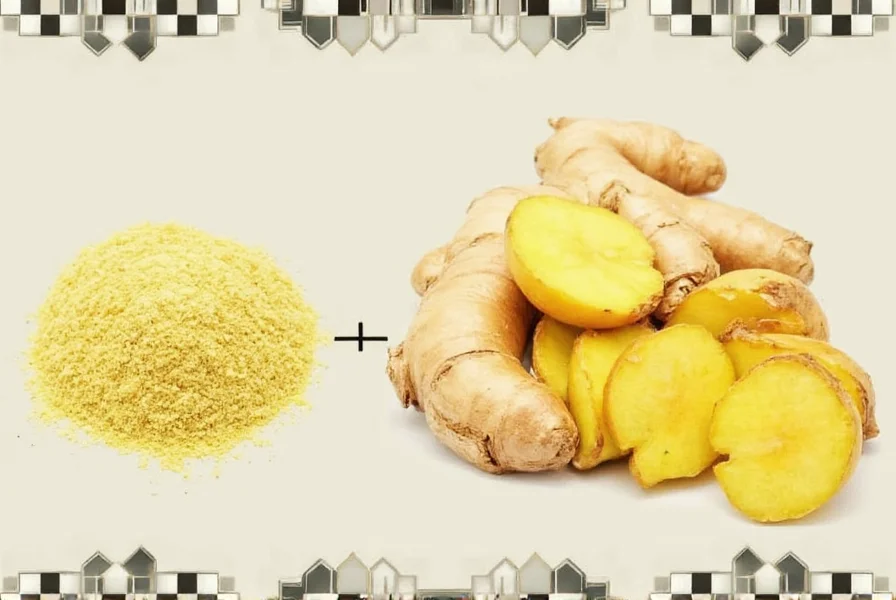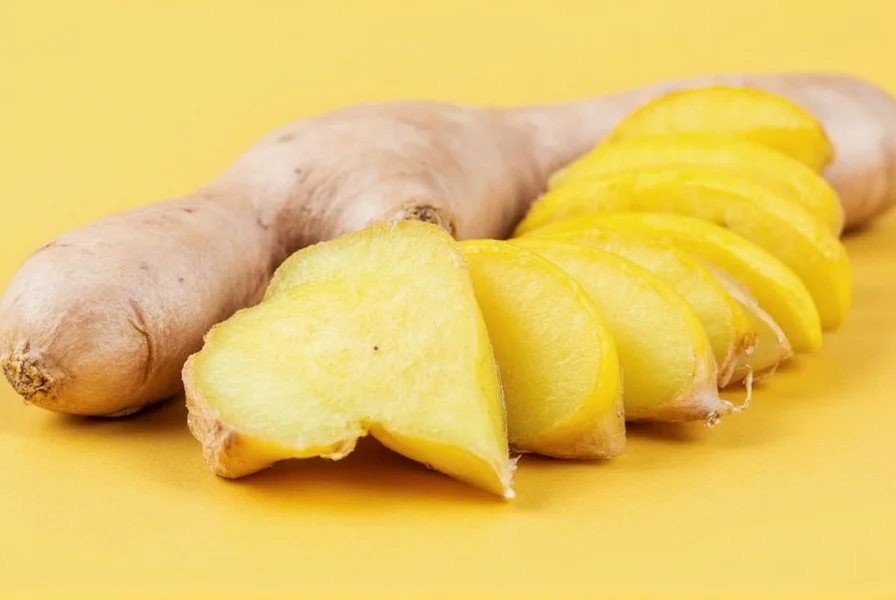The standard fresh ginger to ground ginger conversion ratio is 1 tablespoon freshly grated ginger equals 1/4 teaspoon ground ginger. This 4:1 ratio accounts for the moisture difference between fresh and dried forms. However, the exact substitution can vary based on ginger freshness, recipe type, and personal taste preferences. Always adjust to taste when substituting between these forms in cooking and baking.
Understanding how to properly convert between fresh and ground ginger is essential for home cooks and professional chefs alike. When a recipe calls for one form but you only have the other available, knowing the precise conversion ensures your dishes maintain the intended flavor profile. This guide provides accurate measurements, explains why the conversion isn't always exact, and offers practical substitution advice for various culinary applications.
Understanding Ginger Forms and Their Differences
Fresh ginger root and ground ginger aren't simply different forms of the same ingredient—they have distinct flavor profiles and culinary properties. Fresh ginger contains approximately 70% water, giving it a bright, zesty, and slightly citrusy flavor with a spicy kick. Ground ginger, being dehydrated, has a more concentrated, warm, and slightly sweeter profile with less of the sharp heat found in fresh ginger.
These differences explain why a simple 1:1 substitution doesn't work. When converting fresh ginger to ground ginger measurements, you're not just changing physical form—you're adjusting for water content, flavor concentration, and chemical composition changes that occur during the drying process.
The Science Behind Ginger Conversion Ratios
The standard fresh ginger to ground ginger conversion ratio stems from the dehydration process. When ginger dries, it loses approximately 75-80% of its weight in moisture. This concentration effect means you need significantly less ground ginger to achieve similar flavor intensity.
| Fresh Ginger Measurement | Ground Ginger Equivalent | Best For |
|---|---|---|
| 1 inch piece (about 1 tablespoon grated) | ¼ teaspoon | Most savory dishes, stir-fries |
| 2 inches (about 2 tablespoons grated) | ½ teaspoon | Curries, soups, marinades |
| 3 inches (about 3 tablespoons grated) | ¾ teaspoon | Baking, spice blends |
| 1/4 cup grated | 1 teaspoon | Large batch recipes |
Professional chefs often recommend starting with ⅓ of the standard conversion ratio and adjusting to taste. This accounts for variables like:
- Ginger freshness - Older ginger roots lose moisture and become more concentrated
- Recipe acidity - Acidic ingredients can intensify ginger's heat
- Cooking time - Longer cooking mutes fresh ginger's sharpness
- Personal preference - Some palates detect ginger's heat more intensely
When Substitutions Work Best: Culinary Applications
Not all recipes tolerate ginger substitutions equally. Understanding which dishes accommodate fresh-to-ground ginger conversion helps prevent culinary disappointments.
For savory dishes like stir-fries and curries, fresh ginger generally provides superior flavor complexity. However, when substituting ground ginger in these applications, use the standard 4:1 ratio but add it earlier in the cooking process to allow flavors to develop fully. Consider adding a splash of lemon juice to mimic fresh ginger's bright notes.
In baking applications like gingerbread or spice cakes, ground ginger often works better than fresh. The conversion from fresh ginger to ground ginger in baking typically follows the standard ratio, but many bakers prefer increasing ground ginger by 10-15% to compensate for fresh ginger's moisture content affecting texture.

Adjusting for Recipe Success
Successful substitution requires more than just measurement conversion. Consider these professional tips when converting fresh ginger to ground ginger in your recipes:
- For beverages - Use ⅛ teaspoon ground ginger per cup of liquid when substituting for fresh
- For marinades - Add ground ginger 30 minutes before cooking to prevent bitterness
- For delicate dishes - Reduce ground ginger by 25% compared to standard conversion
- For intense flavor profiles - Increase ground ginger by 10-15% for dishes like chai or mulled wine
Remember that ground ginger's flavor develops more slowly than fresh ginger's volatile compounds. When substituting in quick-cooking dishes, allow at least 5-7 minutes of simmering time for ground ginger to fully release its flavor.
Storage Considerations for Optimal Flavor
Proper storage affects your conversion accuracy. Fresh ginger stored in the refrigerator maintains consistent moisture content for 2-3 weeks, making conversions more reliable. Ginger stored longer or at room temperature loses moisture, becoming more concentrated—requiring slightly less ground ginger when substituting.
Ground ginger retains potency for 6-12 months when stored in an airtight container away from light and heat. Older ground ginger loses potency, potentially requiring up to 25% more than standard conversion ratios. Always check ground ginger's aroma before use—a weak scent indicates diminished potency.

Common Conversion Mistakes to Avoid
Many home cooks make these errors when converting between ginger forms:
- Using equal measurements (1:1 ratio) without accounting for moisture difference
- Not adjusting for recipe type (baking vs. savory dishes)
- Adding ground ginger too late in the cooking process
- Using old ground ginger without compensating for lost potency
- Ignoring personal taste preferences in the conversion
For the most accurate fresh ginger to ground ginger substitution, measure by weight when possible. One ounce (28g) of fresh ginger typically equals 0.25 ounces (7g) of ground ginger—a more precise conversion than volume measurements.
Practical Application: Recipe Adjustments
When modifying recipes, consider these specific examples:
- Stir-fry recipe calling for 1 tablespoon fresh ginger: Use ¼ teaspoon ground ginger added with other dry spices
- Gingerbread recipe requiring 2 tablespoons fresh ginger: Substitute with ½ teaspoon ground ginger plus ⅛ teaspoon cinnamon for complexity
- Smoothie recipe with 1-inch ginger piece: Replace with ⅛ teaspoon ground ginger blended with liquid ingredients first
- Curry recipe specifying 3 tablespoons fresh ginger: Use ¾ teaspoon ground ginger added during the initial oil heating stage
Professional chefs often create a ginger paste by mixing ground ginger with a small amount of water or oil when substituting for fresh in recipes requiring visible ginger pieces. This technique provides both flavor and visual similarity to fresh ginger.
Frequently Asked Questions
Can I substitute ground ginger for fresh in all recipes?
While you can substitute ground ginger for fresh in most recipes, the results vary by dish type. Ground ginger works well in baked goods, spice blends, and long-simmered dishes but doesn't provide the same bright, sharp flavor in quick-cooking applications like stir-fries or fresh sauces. For best results, use the 4:1 conversion ratio and adjust based on recipe requirements.
Why does my dish taste different when I substitute ground ginger for fresh?
Fresh and ground ginger have different flavor compounds due to the drying process. Fresh ginger contains zingerone and shogaols that provide sharp heat, while ground ginger's primary compound is gingerol, which is warmer and less intense. The moisture difference also affects how flavors distribute in dishes. Always adjust the conversion ratio based on your specific recipe and personal taste preferences.
How do I adjust fresh ginger to ground ginger conversion for old ginger root?
As fresh ginger ages, it loses moisture and becomes more concentrated. For ginger root showing signs of drying (wrinkled skin, harder texture), reduce the ground ginger amount by 10-15% from the standard conversion. For example, instead of using ¼ teaspoon ground ginger for 1 tablespoon fresh, use 3/16 teaspoon. Always taste and adjust as you cook for best results.
Does the conversion ratio change for different types of ginger?
Yes, ginger variety affects conversion ratios. Younger, juicier ginger (like spring ginger) may require slightly more ground ginger in substitution (up to ⅓ teaspoon per tablespoon fresh), while mature, fibrous ginger might need slightly less (as little as 3/16 teaspoon). Hawaiian blue-ring ginger has a milder flavor, potentially requiring a 10-15% increase in ground ginger substitution. When in doubt, start with the standard 4:1 ratio and adjust to taste.











 浙公网安备
33010002000092号
浙公网安备
33010002000092号 浙B2-20120091-4
浙B2-20120091-4